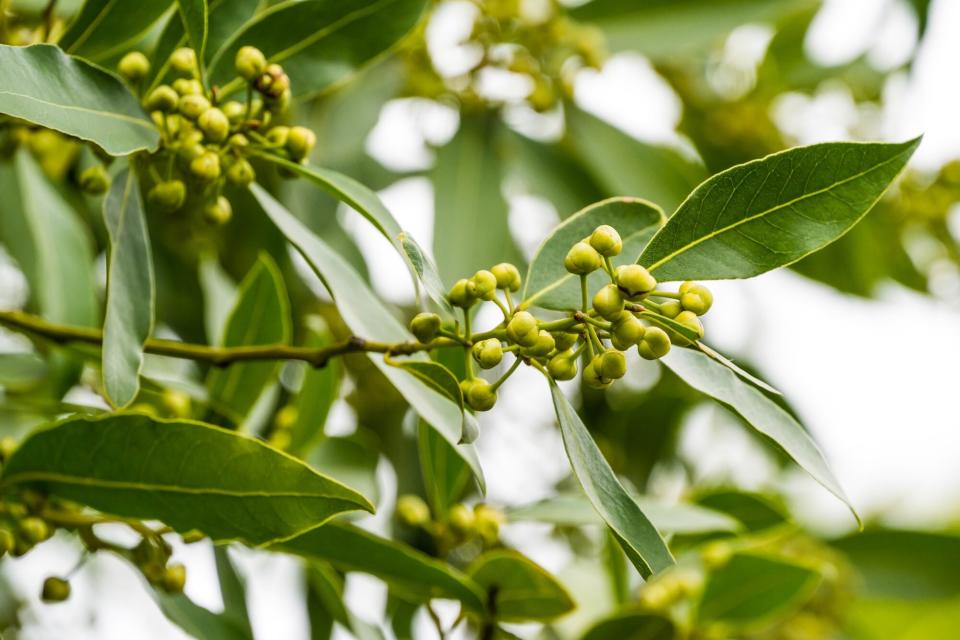How to Grow and Care for Bay Laurel, the Small Tree That Produces Bay Leaves for Cooking
TABLE OF CONTENTS
On This Page
Planting
Care
Repotting
Common Problems
You've probably made several recipes that call for bay leaves (especially if you cook soup regularly), but did you know that you can actually grow your own at home? A bay laurel (Laurus nobilis), the tree that produces these herbs, makes a wonderful addition to most indoor and outdoor garden setups. Here's what you need to know about growing and caring for a bay leaf plant, a culinary garden staple.
How to Plant a Bay Leaf Plant
This is a popular kitchen garden herb, says Tom Monson, the owner of Monson Lawn and Landscaping, who is often asked how to grow bay leaf plants by his clients. "Many people are surprised to learn that growing bay leaves isn't as difficult as they might think," he says.
When planting them outside, select a sunny spot; avoid low-light areas or places where water normally pools after a rainstorm, adds Monson. "Bay leaves need a lot of sunlight and good drainage in order to thrive," he says. "You'll also want to give them plenty of room to spread out, as they tend to be quite large." If you're hoping to add one to your garden, you'll be better off starting with an established plant than trying to start one from seed, says Monson.

Marina Denisenko / GETTY IMAGES
How to Care for a Bay Leaf Plant
If you want to keep your bay leaf plant close to the action, like in your kitchen or on a window ledge inside home, you'll need to do your best to replicate the sunny conditions it craves outside, says Stacie Krljanovic, head groundskeeper and adviser at Patio Productions. Plant your bay laurel in a well-draining potting mix and place it in an area where it will get plenty of light. "Provide humidity for your bay leaf by misting the leaves regularly or by placing the pot on a tray of wet pebbles," Krljanovic says.
Just note that this plant can be toxic to pets, so you'll want to make sure your four-legged friends can't get to it wherever you decide to grow it.
Light
When your plant is outside, you'll want to ensure it's in a location that gets bright, indirect light, says Krljanovic; make sure it has ample space to grow, so it doesn't overcrowd nearby plants, adds Monson. The same light conditions need to be replicated indoors.
Soil and Water
When growing a bay leaf plant indoors, use a well-draining potting mix. You can get away with choosing an all-purpose variety or one especially formulated for edible plants.
And if you're planting outside? Pay extra attention to how quickly your soil dries out between waterings, says Monson. After a thorough soaking post-planting, give the tree a drink before the top layer of soil dries out.
Pruning and Harvesting
This hardy plant doesn't actually require regular pruning. You can get away with trimming it back as you see fit to control both its size and its shape, says Krljanovic, who advises against getting to snip-happy when you do start cutting. "Keep in mind that the leaves are the main source of flavor and aroma, so don't prune too much," she says. Pruning should only be done in the late winter or early spring before the new growth begins. "This will help keep the plant looking tidy, while also encouraging more leaf production," says Monson.
While you can harvest the leaves as needed, you should avoid cutting more than a third of the plant's leaves at a time.
Fertilizer
You'll want to give your bay leaf plant a boost by hitting it with a balanced, water-soluble fertilizer every four to six weeks, says Krljanovic. This should be enough to ensure your plant's health without stressing or over-feeding it.
How to Repot a Bay Leaf Plant
If your plant needs a change of scenery, you'll want to make sure you're slowly sizing up the pot (or garden plot) when you move it. According to Monson, carefully move the root ball into a hole that's slightly bigger than the existing root ball. "Place the plant in the hole and gently fill in the soil around it," he continues, adding that you'll need to give it one good soaking after you move it; water it normally moving forward.

VICUSCHKA / GETTY IMAGES
Common Problems With Bay Leaf Plants
This plant experiences a few common issues, but fortunately, they're easy to identify and fix (if you catch them early, that is).
Insects
Because of their woody stems, bay leaf plants are more likely to fall victim to boring insects (including beetles) that lay their eggs within the wood, killing them in the process. Prune off any affected areas as soon as you spot them.
Bay leaf plants are also a favorite treat for armored and oleander scales. These bugs have been known to latch onto the tree and feed in large groups. Over time, they can cause the leaves to die off, slowly killing back the plant. Introducing natural predators to the plant (like lacewings) can help control them without chemicals.
Canker Diseases
Unfortunately, wood decay and canker diseases can also cause problems. They're both driven by fungal growth and can quickly destroy the tree from the inside out. Preventing overwatering and pruning off diseased branches as soon as you see them are two good ways to prevent these diseases from taking over.

